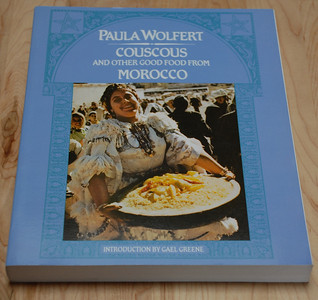
Conveniently enough, I fell in love with Moroccan cuisine while visiting Morocco. All those succulent tagines flavored with tart and tangy preserved lemons and dusky olives. Accompanied by platters of fluffy couscous, these rich, aromatic stews bowled over my taste buds. Then there were the flaky, nut-filled pastries and delicate, filigreed glasses of hot, sweet, minty tea. Utterly enchanting! As soon as I returned home, I set out to recreate those fabulous meals. And what better to aid me in the kitchen than Paula Wolfert’s comprehensive guide to Moroccan cooking, “Couscous and Other Good Food from Morocco” (William Morrow, 1987).
First published in 1973, “Couscous and Other Good Food from Morocco” is the book that not only I but also most other cooks reach for when contemplating an authentic Moroccan meal. No other cookbook has come close to capturing the essence, culture and history of this cuisine. Similarly, no food writer has possessed as much knowledge or has written as beautifully about Moroccan cooking as Paula Wolfert.
In “Couscous . . .” Wolfert explores such quintessential North African dishes as the aforementioned tagines and couscous as well as meatball-like kefta and the coiled “snake cake” m’hanncha. She devotes separate chapters to breads, soups, savory pastries and those tiny grains of semolina that we know as couscous. The latter chapter is particularly beneficial to anyone like me who made the deranged decision to purchase, drag across the country and then lug back home a couscoussiere, the traditional, two-tiered pot that steams couscous. In that chapter Wolfert takes readers step-by-step through the process of rolling, steaming and raking thousands of semolina grains until they become light, airy and, well, couscous.
Wolfert also shares how to make such classic Moroccan seasonings as chermoula, ras el hanout and preserved lemons. Thanks to her, I can whip up my own fish marinade or spice blend and have a cool activity for my dinner guests. Just grab some unwaxed, organic lemons, sea salt and jars and start preserving!
Although it’s written as a cookbook, I tend to use “Couscous . . .” as a guide for my dinners. I’ve never followed the recipes to the letter. In fact, I’ve tinkered with them quite a bit. Yet they’ve served as the basis for many fabulous dishes. Take, for instance, my version of the meat pie bisteeya. Truthfully, I have no hankering for pigeon-stuffed bisteeya or pigeon-stuffed anything. Instead I, like most modern cooks, substitute shredded chicken, sans giblets, for the filling and phyllo for the tissue-thin warka leaves. I also alter some of her seasonings. Likewise, I cut the ingredient amounts as I rarely cook for 12.
Whether you carry out the recipes verbatim or play around with them as I do, you’re bound to learn quite a bit from this comprehensive cookbook. If you love Moroccan food, you’ll love “Couscous and Other Good Food from Morocco.” It’s an undisputed classic and an essential tome for anyone craving authentic Moroccan cooking.